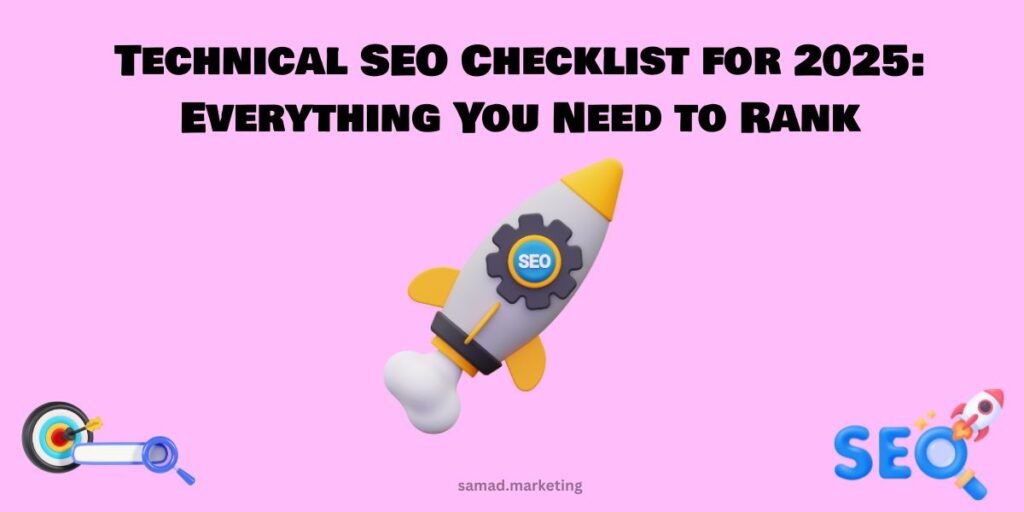If you want your website to rank on Google in 2025, technical SEO is a must. Even with high-quality content and backlinks, a poor technical setup can stop your site from performing well. In this blog post, we’ll go through a complete, easy-to-follow technical SEO checklist that will help you build a solid foundation for search engine success.
✅ 1. Make Sure Your Website Is Mobile-Friendly
With Google’s mobile-first indexing, your site must work perfectly on smartphones. Test your website using Google’s Mobile-Friendly Test. Make sure:
- Fonts are readable without zooming
- Buttons are large and easy to click
- Content fits the screen without horizontal scrolling
- Menus and navigation are simple on smaller screens
✅ 2. Improve Site Speed
Page speed affects both user experience and search rankings. Use tools like Google PageSpeed Insights or GTmetrix to analyze and fix speed issues. Focus on:
- Compressing images without losing quality
- Using fast, reliable hosting
- Enabling browser caching
- Reducing JavaScript and CSS files
- Using a content delivery network (CDN)
✅ 3. Use HTTPS (Secure Your Site)
If your website still uses HTTP, it’s time to switch. Google considers HTTPS a ranking factor. Make sure:
- You have an SSL certificate installed
- All pages redirect to the HTTPS version
- Mixed content issues (HTTP resources on HTTPS pages) are fixed
✅ 4. Fix Crawl Errors
Use Google Search Console to identify crawl issues. These are problems Googlebot faces while trying to access your website. Check:
- 404 error pages (broken or missing)
- Redirect errors (302 instead of 301)
- Blocked pages in robots.txt
- Server errors (5xx status codes)
Fixing these ensures that search engines can access and index your content correctly.
✅ 5. Optimize Your Robots.txt and Sitemap.xml Files
Your robots.txt file tells search engines which pages not to crawl. A misconfigured file can block important content. Make sure:
- Important pages are not accidentally disallowed
- The Sitemap URL is included in the robots.txt file
Your sitemap.xml helps search engines discover pages. Submit it in Google Search Console and Bing Webmaster Tools.
✅ 6. Ensure Clean URL Structures
SEO-friendly URLs are short, clear, and keyword-rich. Avoid URLs that look like this:
https://yourdomain.com/page?id=1234
Instead, aim for:
https://yourdomain.com/seo-checklist
Also, make sure
- URLs use hyphens (not underscores)
- URLs are in lowercase
- There are no unnecessary parameters
✅ 7. Use Structured Data (Schema Markup)
Schema markup helps search engines understand your content better. It can also boost your appearance in search results with rich snippets like
- Ratings
- FAQs
- Product details
- Recipes
Use Google’s Structured Data Markup Helper to get started, and test your pages using the Rich Results Test.
✅ 8. Avoid Duplicate Content
Duplicate content confuses search engines and can hurt your rankings. Use tools like Siteliner or Screaming Frog to find and fix:
- Duplicate title tags and meta descriptions
- Multiple URLs pointing to the same content
- Canonical tags to indicate the preferred version of a page
✅ 9. Check Internal Linking Structure
A strong internal linking structure helps:
- Pass link authority to important pages
- Improve crawlability
- Keep users on your site longer
Tips:
- Link from blog posts to related services or products
- Use descriptive anchor text (not “click here”)
- Make sure no pages are orphaned (without internal links)
✅ 10. Optimize for Core Web Vitals
Google’s Core Web Vitals measure real user experience. Focus on:
- Largest Contentful Paint (LCP)—how fast the main content loads
- First Input Delay (FID)—how soon users can interact
- Cumulative Layout Shift (visual stability during loading)
You can measure these using PageSpeed Insights or Chrome Lighthouse.
Final Thoughts
Technical SEO isn’t just for developers. Even non-coders can follow this checklist to make a big impact. To improve your website’s rankings and attract more visitors, make sure it is fast, secure, mobile-friendly, and easy for search engines to read.
If you want to learn more, keep an eye out for upcoming blog posts that will cover advanced SEO tactics and strategies to help your website succeed in 2025 and beyond.

